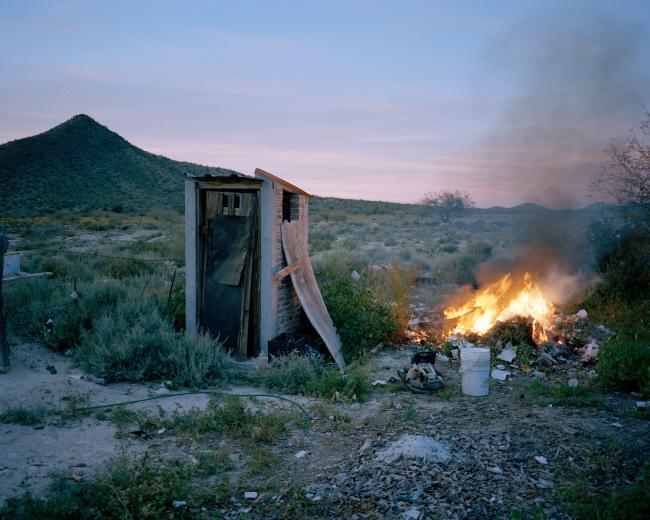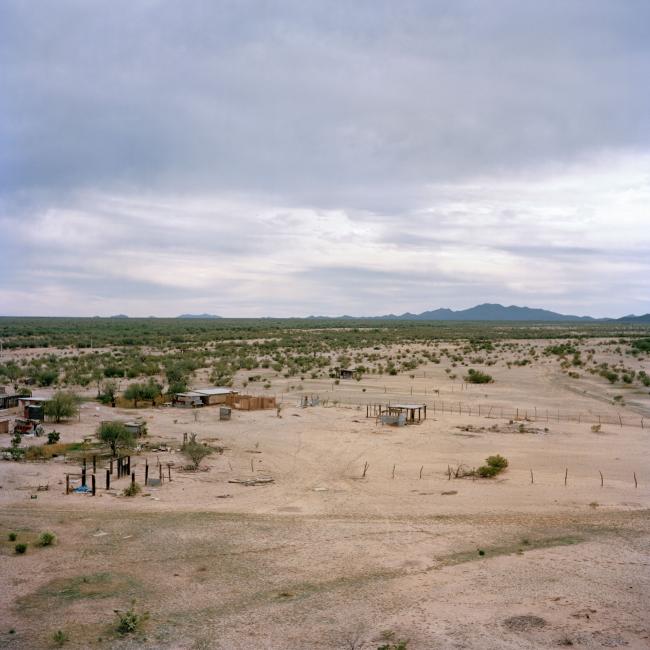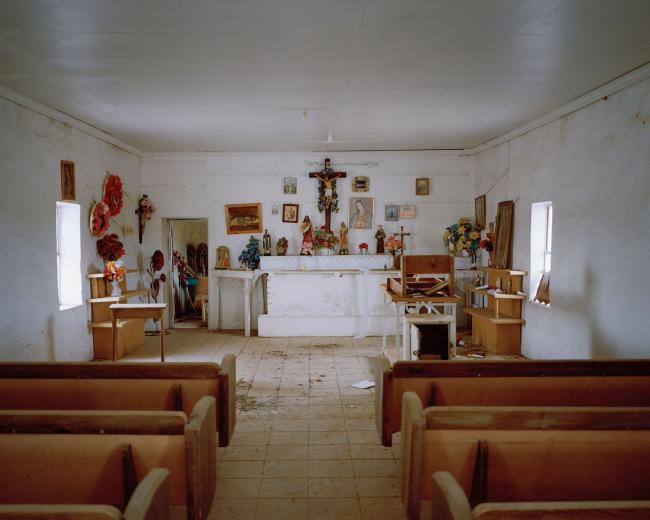
Once in Puerto Peñasco, the ocean breeze and scattered palm trees offer relief from the harsh sun. “As a Tohono O’odham traditional leader of my community, I attend monthly meetings with fellow leaders of all the tribe jurisdictions to discuss how to protect and help out our people,” Lizarraga explains to me as she heads to July’s meeting. The underlying topic on every item on the agenda: the U.S.-Mexican border.
The border, imposed on the Tohono O’odham by the U.S. and Mexico in 1853 through the Gadsen Purchase, has been a core issue for the community ever since. The border divided and compartmentalized the Tohono O’odham and their sacred land, threatening their traditional culture and economy. Access to key natural resources depended on free and extensive mobility through the desert, which was disrupted by the border line. Family and communal ties also waned as the O’odham had to adapt to different languages and national idiosyncrasies. Border crossing regulations changed over the years, preventing O’odham from visiting family or sacred sites, as well as seeking education or attending medical appointments.
In the past few years, Trump’s intention to build a border wall has increased the obstacles. Trump’s rhetoric feeds into an already critical situation for the O’odhams, exacerbating issues including forced displacements, aggressive resource extractive projects, rising surveillance and harassment by state forces, and smuggling activity. Faced with such challenges, the O’odham are struggling to defend the sacredness of the territory and the integrity of its nation, but the adopted course of action is stemming controversies along the Nation. The tribal administration has been collaborating with Border Patrol to militarize the border and has adopted part of Trump’s vocabulary and strategies towards illegal immigration. In opposition, concerned O’odham citizens have started advocating both for the environment and for welcoming immigrants, stressing the dangers of their government collaborating with border enforcement.
Tohono O’odham Historical Oversight
After the end of the Mexican-American War in 1848, the Treaty of Guadalupe Hidalgo set a new border between the two countries, which resulted in dividing the Tohono O’odham territory into a Mexican side and a U.S. side. This first division completely changed the dynamic of the communities, who saw their centuries-old subsistence patterns of mobility through the Sonoran Desert and up to the north of the California Gulf transformed into a precarious seasonal migration into whichever ranch, plantation, or mine employed them.
Then came the second division. In 1853, the U.S. government, with the hope of expanding its southern railway network, purchased the far southern portions of present-day New Mexico and Arizona from Mexico through the Gadsden Purchase. This left a small handful of O’odham towns on the Mexican side even more isolated.
With the creation of a formal reservation for the tribe in U.S. lands in 1916— only a fraction of the traditional territory stretching across both sides of the border that O’odham people historically occupied—the compartmentalization of the Tohono O’odham increased. O’odhams on the U.S. side were more economically and socially protected, but the remaining Mexico O’odham towns struggled to maintain their traditional way of living. Crossing into the United States also became increasingly difficult. Over the last ten years, U.S. Border Patrol and private landowners closed all but one of the traditional gates used for centuries by the O’odham, obliging them to cross through major far away checkpoints in Lukeville, Sásabe, or Nogales.
Gabriela Lizárraga Juárez, representative of one of the biggest O’odham jurisdictions in Mexico, told me that since the immigration crisis has spiked, crossing regulations for the O’odham have tightened. O’odham living in Mexico are now required to have a U.S. citizenship or a visa to cross the border. Their tribal ID, which before served as a crossing document, now is valid only to attend doctor’s appointments. Crossings with the tribal ID for family or cultural reasons are no longer possible.
After more than 120 years of separation, the O’odhams still face the same issues. Under President Trump, the layers of neglect and disdain are only worsening.
The Threat of the Wall
The planned 100 miles of border wall lie partly on nationally protected land, with much of the area belonging to the Tohono O’odham ancestral territory. Tohono O’odham leaders have expressed their concerns during the last several years over the environmental impact of a border wall, including a brief filed against the Trump administration as part of a U.S. Supreme Court case. In it, the O’odham Nation stressed “the significant and irreparable harm to the Nation” the wall will cause, referring not only to the threat to natural and cultural resources but also to public safety, through increased border-crossing traffic. The wall is projected to end less than two miles from the western boundary of the Nation’s reservation and to resurface in isolated places in New Mexico, leaving almost the entirety of the Tohono O’odham Reservation as the only way into the United States. In the brief, O’odham leaders cited possible negative consequences, including “border-related thefts, litter, land desecration, destruction of natural resources, migrant rescues and deaths, drug trafficking and human smuggling.”
While the conversation on the border is stagnated in U.S. bipartisan politics, the Tohono O’odham Nation’s government advances an ambivalent, almost chameleonic position. On the one hand, it backs progressive complaints against the environmental impacts of the border wall. At the same time, though, it depicts immigration with a vocabulary similar to the one used by Trump’s administration—as a threat.
Verlon Jose, the vice-chairman of the Tohono O’odham Nation until a few months ago, declared in an interview with NPR that migrants usually “break in and help themselves to food and water.” Though differentiating drug smugglers from occasional border crossers, Verlon’s vocabulary feeds the current frenzy against migrants inside the Nation.
The Tohono O’odham government’s position not only arises from the recent border-wall discussions. Since at least 2008, the Nation’s administration has been preventing human rights advocates of the NGO Humane Borders from placing water tanks and supply stations on reservation lands, with the belief that the organization’s efforts could encourage migrants to cross through the Nation’s land.
The Nation also cooperates with Customs and Border Protection (CPB) to enforce the border. The tribal government spends $3 million annually on border security, deploying its own tribal police. On March 22, the Nation’s legislative council passed a resolution to allow CBP to build roads and preparation sites for 10 surveillance towers to be built on the reservation, which transformed the reservation into the “most militarized community in America,” as Todd Miller wrote for In These Times. The system will be built by the Israeli defense company Elbit Systems at an estimated cost of $26 million. For the Nation, the surveillance towers are a small price to pay in order to prevent the wall construction through native land.
Regardless of the official position of the Nation, O’odham citizens’ are reacting against border enforcement and unjust treatment to migrants. The activist group O’odham Voice held a protest on August 31 against the wall and the surveillance towers. O’odham Solidarity Project, which advocates for a more humane border, is also organizing activities and raising funds to cover travel, food, and lodging expenses for activists protesting against the border.
The Backdrop of the Wall
A snapshot of what is happening at the backdrop of the wall discussion can help to understand why the Nation’s administration is struggling to find a middle ground on the border issue. Forced displacements, aggressive resource extractive projects, and rising surveillance and harassment by state forces impact an already divided and clustered community.
Reuben Naranjo, an O’odham artist, detailed a growing number of cases of Tohono O’odham citizens being harassed by Border Patrol, either while traveling through the reservation or on their own private property. According to Naranjo, “There are daily posts on Facebook showing Border Patrol harassment.” He pointed specifically to a case of a 20-year-old boy run over by a Border Patrol pick-up truck on the private property of an O’odham woman and her grandchild, which was captured on video.
According to Naranjo, there are countless stories of Tohono O’odhams being stopped by Border Patrol, profiled for their skin color. “My 80-year-old grandmother was handcuffed and put to the ground with my nephews while Border Patrol verified their tribal IDs, only because they were not white,” he said. “Most Border Patrol agents don’t have respect for this land or its people.”
Extractive projects endanger natural resources that are sacred to the O’odham south of the border, including the salt fields at Sea of Cortez and the “low-cost” cyanide heap-leach gold mining projects at Quitovac.
Quitovac’s community leader Doraly Velasco Leon said there are now two contracts with Silver Scott Inc., signed in 2009 and 2011, which consist of almost 14,500 hectares of land concessioned for exploration and exploitation. Velasco Leon emphasized that the Quitovac community assembly unanimously approved these contracts, but the mining projects have still instigated controversy from other O’odham communities.
The mining projects at Quitovac raise fundamental issues for the O’odhams. On the one hand, the mine poses a threat to the sacred land and its natural resources.On the other, it stimulated the economy of a town that was doomed to disappear. Situated on the Mexican side of the Sonoran Desert, Quitovac suffered the consequences of the imposed border and its isolation from the Nation. Once an important O’odham town for its vicinity with the Quitovac Pond—one of the few water sources of the desert and a sacred O’odham place—the last Mexican census of 2010 counted only 75 inhabitants. Now, because of the mine, Quitovac receives seasonal workers that need accommodation, food, schooling, and services for their families, all of which alleviate the burden of economic pressure and rural-urban migration that is common in the area.
Wo’osan, or El Bajío in Spanish, was one of the O’odham communities that slowly waned under the pressure of the border. Originally located near San Miguel’s Gate—one of the traditional Tohono O’odham crossings on the border—Wo’osan had nearly no access to water or arable lands, so its subsistence depended highly on cattle and seasonal migration to other towns, especially on the U.S. side of the border. San Miguel’s Gate offered economic relief as well, as it used to be an informal food market and a place of gathering and passage for tribal members. In the past three years, though, the land surrounding San Miguel’s gate was sold and the gate was closed. O’odham families that had been living in the area for centuries didn’t have any documents to prove their property of the land. The San Miguel Gate, once lively and crucial to their subsistence and mobility, was transformed into a highly surveilled foot path. Cars are no longer allowed to cross, which cut the Wo’osan off from its supply and road networks with near US towns.
According to Naranjo, “People just left and never came back. Their ranches are still there, but there’s no reason to come back.”

Only a few miles west from the former site of Wo’osan lies another Tohono O’odham ghost town. Cu:wĭI-ge:ṣk, also known as San Francisquito—an important O’odham town and religious centre—has been deserted since 2015, when drug violence caused mass forced displacement from the area.
The Mexican Commission for the Promotion and Defense of Human Rights (CMDPDH) defines forced displacement as a violation of human rights that occurs when individuals or groups of people flee their home or place of habitual residence—whether to a nearby city or to an entirely different state—to avoid generalized violence, or to escape it after being victimized.
According to the last report published by the CMDPDH in 2019, in the Mexican state of Sonora, where Cu:wĭI-ge:ṣk is situated, organized criminal activities displaced over 180,000 people between 2011 and 2018.
In May 2015, local journalists depicted Desierto de Sonora, the nearest city to Cu:wĭI-ge:ṣk, as a war zone, reporting an escalation of violence from isolated shootouts between the Mexican army and two different organized criminal groups disputing the area.
The effects of this guerra were later felt in Cu:wĭI-ge:ṣk. Reports by private citizens and community leaders, who asked to remain anonymous, mentioned day-long armed confrontations, levantones (kidnappings or enforced disappearances), hostage situations, violent murders, rapes, and a generalized state of violence that lasted for months until the whole community was displaced in May 2015.
“We want to know if we can go back—what is the potential for the community to come back,” repeated Ofelia Zepeda, an O’odham scholar and poet living in Tucson, when shown recent images of Cu:wĭI-ge:ṣk.
Ofelia Zepeda remembers when she went as a child to Cu:wĭI-ge:ṣk with her family for the “October Feast,” one of the most important festivities for the O’odham: “It was a party atmosphere. Most people would come, Mexican vendors would come, they would sell drinks and food. The church would be decorated and full of people, full of life.” Her childhood memories contrast with the present-day situation of the town. “It is shocking to see the church destroyed and dirty. Churches are not supposed to be like that. Churches are supposed to be taken care of, but there is no one there to take care of it. It’s on its own, sitting there, waiting for somebody to come back and fix it. To clean it.”

The abandoned ranches of Wo’osan and the threat to Sonoran wildlife, and to O’odham traditions, are indicators of why a strengthened border and a physical wall cannot be accepted as a solution. However, the illegal smuggling activities related to the border forces the Tohono O’odham Nation administration to abide by the discourse of enhanced security and migrant criminalization, despite resistance from its citizens. The Nation is juggling impossible conditions of how to deal with a long-evolving, seemingly impossible issue—how to accommodate the “sacred” and the “native” into the geopolitical dynamics of modern states.
Cemamagi, Tumamoc
Babad Do’ag, Santa Catalina Mountains
Cuk Do’ag, Black Mountains, Tucson Mountains
Cew Do’ag, Tincon Mountains
Giho Dog, Kihotoa, Burden Basket Mountain
Waw Giwulig Do’ag, Baboquivari Mountain
It has been said before,
These mountains will not listen
If we simply speak words to them.
They will only hear us
if we come with melody, rhythm,
pitch, harmony.
To these circling mountains
we must speak with voices
in songs, rhythmic speeches, orations, and prayers.
We must be prepared with repetition,
a singular, undisturbed beat.
That is the way of the mountains.
This is what they want to hear.
(Excerpt from “Music Mountains”, Where Clouds Are Formed, Ofelia Zepeda, 2008)
Martín Zícari is a writer and historian based in Brussels, Belgium. He has published articles, chronicles, fiction and poetry in several countries in the Americas and Europe. He is also pursuing a Ph. D in Literature and Cultural studies at KU Leuven in the ERC Project ‘Digital Memories.’
This piece received funding from Magnum Foundation and the European Research Council (ERC) under the European Union’s Horizon 2020 research and innovation program. (Grant agreement no. 677955)

